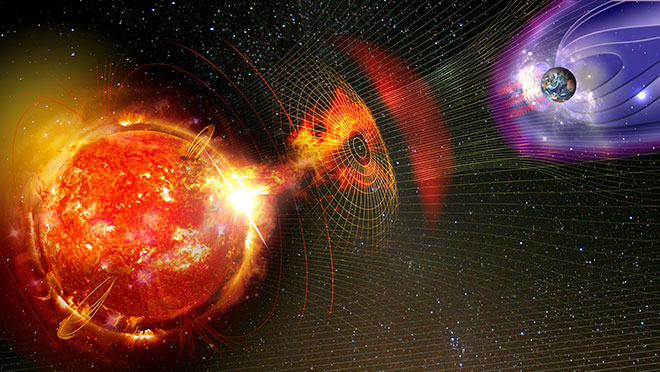Radiation is a medium for transfer of energy which does not requires any medium to carry energy. This is the reason it seems in space which is combinedly called cosmic radiation and in this the radiation released from sun is called Solar radiation. Earth is a planet which faces solar radiation but the question is how Earth defends itself from this type of radiation. In today's topic we will discuss about it. Let's begin

How Earth Defends Itself from Solar Radiation
The Earth is constantly bombarded by solar radiation, a stream of charged particles emitted by the Sun. Despite this, our planet has developed several natural defenses to protect life from these potentially harmful rays. Here’s a look at how Earth shields itself from solar radiation and the impacts of these defenses.
1. The Magnetosphere
The Earth’s magnetic field, known as the magnetosphere, is one of the primary defenses against solar radiation. Generated by the movement of molten iron in the Earth’s outer core, the magnetosphere extends far into space and forms a protective bubble around the planet. When charged particles from the solar wind encounter the magnetosphere, they are deflected away from Earth. This interaction can also create stunning auroras near the polar regions.
Impact: Without the magnetosphere, solar wind could strip away the Earth’s atmosphere, making it impossible for life to exist. The magnetosphere also protects technological systems, such as satellites and power grids, from solar storms that could cause significant disruptions.
2. The Atmosphere
The Earth’s atmosphere acts as a secondary shield. It absorbs and scatters solar radiation, particularly harmful ultraviolet (UV) rays. The ozone layer, located in the stratosphere, plays a crucial role in this process by absorbing the majority of the Sun’s UV radiation. Without the ozone layer, these rays could cause severe damage to living organisms, including increased rates of skin cancer and cataracts in humans.
Impact: The atmosphere’s ability to filter solar radiation is vital for maintaining the planet’s climate and supporting life. Changes in the atmosphere, such as ozone depletion, can lead to increased UV exposure, affecting ecosystems and human health.
3. Albedo Effect
The Earth’s surface also contributes to its defense against solar radiation through the albedo effect. Albedo refers to the reflectivity of the Earth’s surface; surfaces like ice, snow, and clouds reflect a significant portion of incoming solar radiation back into space. This reflection helps regulate the planet’s temperature and prevents excessive heating.
Impact: The albedo effect is crucial for climate regulation. Changes in surface reflectivity, such as melting ice caps, can lead to increased absorption of solar radiation, contributing to global warming and climate change.
4. Heliosphere
Interestingly, the Sun itself provides a form of protection through the heliosphere. The heliosphere is a vast bubble of solar wind and magnetic fields that extends well beyond the orbit of Pluto. It acts as a shield against cosmic rays and interstellar radiation, reducing the amount of harmful radiation that reaches the inner solar system, including Earth.
Impact: The heliosphere helps to maintain a stable environment in the solar system, protecting Earth from high-energy cosmic rays that could otherwise penetrate the atmosphere and cause damage to living organisms and technological systems.
Conclusion
The Earth’s ability to defend itself from solar radiation is a testament to the intricate and interconnected systems that sustain life on our planet. From the magnetosphere and atmosphere to the reflective properties of its surface and the heliosphere, these natural defenses work together to create a habitable environment. Understanding and preserving these protective mechanisms is crucial for the continued health and safety of all life on Earth.
